An epicurean adventure to: Italy
This Spaghetti Arrabiata recipe is a delicious, quick, and satisfying meal that's bursting with bold and spicy flavours. It's a classic Italian dish made with tonnes of garlic, red chilli flakes for spice, chopped tomatoes, onions and fresh basil.
Don't forget to round it off with a generous flourish of parmesan!
It's incredibly easy to make and can be whipped up in just 30 minutes, making it a perfect choice for busy weeknights or impromptu get-togethers.
It's also a versatile dish that can be enjoyed on its own or paired with your favourite protein or veggies.
The origin of Spaghetti Arrabiata can be traced back to the Lazio region in central Italy, particularly the city of Rome. It is believed to have emerged in the mid-20th century as part of traditional Roman cuisine.
Spaghetti Arrabiata serves as a prime example of the Italian culinary philosophy, which emphasises the use of fresh, quality ingredients to create flavourful dishes with minimal fuss.
For another super speedy mid-week pasta dish, try this recipe for lemon garlic pasta. You can have it on the table in 15 minutes.
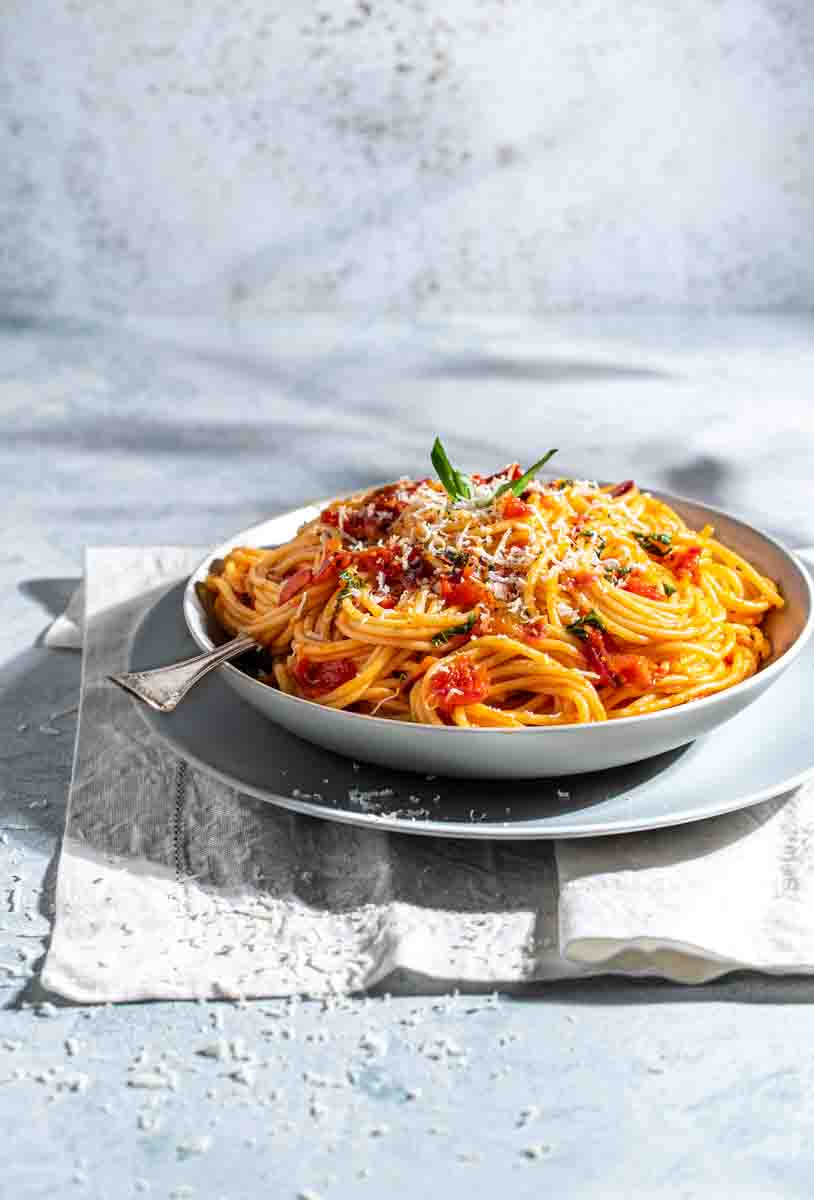
Jump to:
- Fast facts - Italy
- What's to love about this recipe
- What does Arrabiata mean?
- Key ingredient notes and substitutions
- How to make this recipe - Quick summary
- Top tips
- Serving suggestions
- Storage and reheating
- What else can Arrabiata sauce be used for?
- More pasta recipes for you to try
- FAQ
- More easy weekday dinners that take less than 30 minutes to make
- Recipe
Fast facts - Italy

| Location | Italy is located in Southern Europe, bordering France, Switzerland, Austria and Slovenia. |
| Language | Italian is the official language of Italy and it's spoken by the majority of the population. However, there are also many regional dialects and languages spoken throughout the country. |
| Population | Circa 60 million people. |
| Trivia | Italian opera has a rich heritage, with composers such as Giuseppe Verdi, Giacomo Puccini and Vincenzo Bellini producing timeless works. The Teatro alla Scala in Milan is one of the most prestigious opera houses in the world. |
What's to love about this recipe
- Bold and vibrant flavours with a medium spice level.
- Quick and effortless to prepare in less than 30 minutes. This easy pasta recipe is an excellent choice for a quick weeknight dinner.
- It's a versatile dish, add your favourite protein or veggies to the meal.
- It's a relatively healthy dish that can be made even healthier by using wholegrain spaghetti.
- It's economical and made with simple, inexpensive ingredients. You can skip the pricey parmesan and use the parmesan look-a-likes many stores now have on offer.
- Can be made vegan-friendly with a vegan replacement for parmesan
What does Arrabiata mean?
"Arrabiata" is an Italian word that translates to "angry" or "furious." In the case of Spaghetti Arrabiata, the name reflects the dish's bold and intense flavours.
So there you have it, angry spaghetti.
Please note that the correct spelling is "Arrabbiata" with two Bs, but the single B version has been commonly adopted by most people.
Key ingredient notes and substitutions
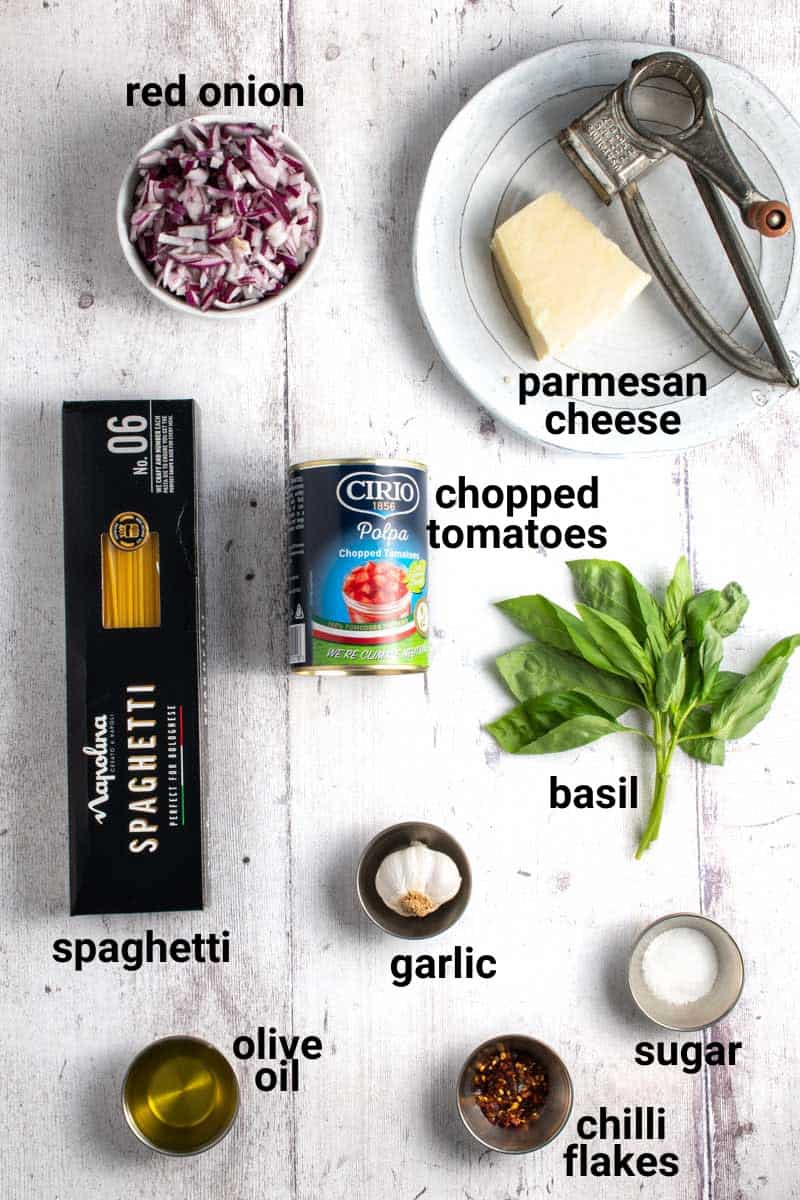
**Please see the recipe card at the bottom of this post for the full recipe and list of ingredients.
Spaghetti
If possible, aim to use high-quality spaghetti because it's the star of this dish. A good quality will just make the meal even more enjoyable.
For a super healthy and low-calorie alternative, try using this Arrabbiata sauce as a topping for courgette/zucchini noodles.
Red onion
Can be replaced with white onion, brown onion, yellow onion or even shallots.
Garlic
Lots of it! Feel free to use plenty of fresh garlic in this recipe.
The instructions suggest four garlic cloves, but if your garlic bulbs are on the small side, you might want to consider adding 5-6 cloves instead.
Chopped tinned tomatoes
We use tomatoes from a tin for convenience's sake. Most tins weigh around 400g, which is conveniently what the recipe calls for.
Fresh tomatoes work wonderfully for this recipe too, you will just need to remove the skins first.
To make peeling the skins of whole tomatoes easier, score a light crisscross across the surface of each tomato and then soak them in very hot water for a few minutes. The skins should come off easily.
If using fresh tomatoes, you might need to cook the sauce for a couple of minutes longer to make sure the tomatoes become nice and soft. Tinned tomatoes are already slightly softer than fresh ones.
Flavourings
You can adjust the amounts of red chilli flakes and basil according to your personal taste.
You can substitute red chilli flakes for red pepper flakes, but be warned, red pepper flakes tend to be hotter. Start with half the amount and add more to your preference.
Sugar
We add a small amount of sugar to balance out the acidity that comes from using a generous amount of tomatoes in the dish. Rest assured, it won't make the dish sweet.
Salt and pepper
We haven't added salt and pepper to the ingredient list because you can adjust this to taste.
As a guide, we tend to salt three times,
1. When cooking the spaghetti.
2. Adding more to the spaghetti after rinsing it under cold water.
3. A pinch of salt for the sauce.
Parmesan
If you prefer, you can use Pecorino Romano or Parmigiano Reggiano as substitutions for parmesan cheese.
We appreciate that these cheeses can be expensive these days. Alternatively, you can opt for 'grated hard cheese' available in many supermarkets, which tends to be more budget-friendly.
While it won't be exactly the same, it will still provide a similar taste.
How to make this recipe - Quick summary
Prepping
- Cook the spaghetti al dente according to the package instructions. Season to taste.
- Drain, rinse with cold water and add a glug of oil to stop the strands from sticking to each other.
- Check for seasoning again.
- Chop the onion and basil and mince the garlic.
To make the pasta sauce
- Start by adding olive oil to a pan and heating it over medium heat.
- Sauté the garlic and onions together until the onions become soft and translucent.
https://languages.oup.com/Sauté - fried quickly in a little hot fat.
- Next, add the tomatoes, basil, chilli flakes and sugar to the pan. Sauté the mixture over low heat until the sauce reduces and thickens slightly.
- Add salt and pepper to taste.
Assembling the Arrabiata
- Now, add the cooked spaghetti to the pan and toss it through the spicy tomato sauce.
- Keep tossing the pasta over low heat for about 4 minutes until it's heated through.
- Remember to check for salt and pepper and adjust the seasoning according to your taste.
- Spoon into pasta bowls and generously top with fresh parmesan cheese and a few grinds of black pepper.
Top tips
- When cooking the spaghetti, it's best to use a generous amount of water in a large saucepan.
This ensures that the spaghetti cooks thoroughly and prevents the strands from sticking to each other.
- Be mindful not to overcook the spaghetti. To check if your spaghetti is cooked al dente, consider the following factors:
- Texture - Al dente pasta should have a firm, slightly chewy texture. It shouldn't be soft or mushy.
- Visual clues - When you break a strand of al dente spaghetti in half, it should have a white, starchy core. If the pasta is uniformly translucent, it's overcooked. If it's opaque or hard in the centre, it's undercooked.
- Texture - Al dente pasta should have a firm, slightly chewy texture. It shouldn't be soft or mushy.
- To check if the sauce has reduced enough, pay attention to the sides of the pan.
When you initially add the tomatoes, you'll notice a significant amount of liquid bubbling up around the edges of the sauce. As you continue cooking, the liquid level will gradually decrease.
The sauce is usually ready when the bubbles become smaller and less frequent, indicating a thicker consistency.
- When tossing the spaghetti with the sauce, using an 'up-and-over' movement can be helpful.
By grabbing the spaghetti from below and lifting it over the top, you can usually bring the sauce with it from beneath the pasta.
This technique helps to ensure that the spaghetti gets evenly coated with the sauce.
Serving suggestions
- Can be served as a stand-alone main dish. Top with parmesan or other hard cheese, fresh basil leaves, black pepper and extra virgin olive oil.
- Top with your favourite grilled meats, like chicken, prawns or shrimp.
- Top with grilled vegetables like aubergine, courgette, red peppers or mushrooms.
- Serve with garlic bread.
- Serve with a side salad, like this panzanella toscana salad.
- Add additional fresh herbs like oregano.
Storage and reheating
To store leftover spaghetti, you can use an airtight container and keep it in the fridge for up to three days.
Before storing, allow the pasta to cool down to room temperature. Then, transfer it to the airtight container and make sure to cover it tightly to maintain freshness.
Reheating
To reheat the pasta, you have a couple of options. One way is to add it to a saucepan with a small amount of water. Heat the pasta over medium heat, stirring occasionally, until it's heated through.
Alternatively, you can reheat the pasta in the microwave. Place it in a microwave-safe dish and cover it loosely with a lid or damp paper towel. Heat the pasta on high for 30-second intervals, stirring in between, until it's heated through.
Freezing
You can freeze the pasta, but it's important to note that pasta dishes may become slightly mushy after being frozen, defrosted and reheated.
To defrost the frozen pasta, simply remove it from the freezer the day before you plan to eat it and let it thaw in the fridge overnight. Then, follow the reheating instructions mentioned above.
What else can Arrabiata sauce be used for?
- A pizza base topping.
- Meatball sauce.
- Marinade for chicken and shrimp.
- Use as a spread in wraps for a spicy kick.
- Shakshuka base.
- As a dip.
More pasta recipes for you to try
Pasta Fredda - Cold Italian salad
FAQ
Arrabiata and Bolognese are both Italian tomato-based sauces, but they have some key differences in their ingredients and preparation:
Arrabiata sauce is a spicy tomato-based sauce that typically includes garlic, red chili flakes, and olive oil. It is usually served with pasta and has a bold, spicy flavour profile.
Bolognaise sauce is a meat-based sauce that typically includes ground beef or pork, onion, celery, and carrots, as well as tomatoes and sometimes red wine.
It is a hearty sauce that is often served with pasta such as spaghetti or tagliatelle. Bolognese sauce has a rich, savoury flavour and is usually not spicy.
For this recipe it's 426 calories per portion.
It is a reasonably healthy dish, yes.
The main ingredient being the spaghetti can be replaced with wholegrain spaghetti for a healthier option. Tomatoes, onions, garlic and basil are all low calorie, nutritious ingredients.
Olive oil is rich in monounsaturated fatty acids (MUFAs), which are considered healthy fats that can help improve cholesterol levels and reduce the risk of heart disease.
More easy weekday dinners that take less than 30 minutes to make
Recipe
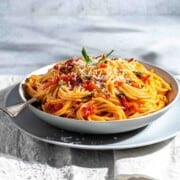
Spaghetti Arrabiata
Ingredients
- 350 grams spaghetti
- 2 tablespoons olive oil - and an extra glug to add to spaghetti once cooked
- 1 red onion - chopped
- 4 cloves of garlic - minced
- 400 grams tin chopped tomatoes - or you can use fresh tomatoes, see blog post for instructions.
- 2 tablespoons chopped basil - should be heaped spoons
- 1 teaspoon red chilli flakes
- 1 teaspoon sugar
- grated parmesan for scattering over the pasta - or Pecorino Romano
Instructions
Prepping
- Cook the spaghetti according to the packet instructions until al dente. Salt to taste.
- Drain the spaghetti in a colander and rinse with cold water.
- Transfer back to the saucepan and stir through a good glug of olive oil to keep the strands separated. Taste for salt and add more if needed.
- Chop the onions and fresh basil. Mince the garlic.
To make the sauce
- Start by adding olive oil to a pan and heating it over medium heat.
- Sauté the garlic and onions together until the onions become soft and translucent. Keep the heat low so the onions don't brown too fast, you want to cook it gently and slowly.
- Next, add the tomatoes, basil, chili flakes and sugar to the pan. Sauté the mixture over low heat until the sauce reduces and thickens slightly.
- Add salt and pepper to taste.
Assembling the Arrabiata
- Now, add the spaghetti to the pan and toss it through the Arrabiata sauce.
- Keep tossing the pasta over low heat for about 4 minutes until it's heated through.
- Check for salt and pepper, add more according to taste.
- Spoon into pasta bowls and generously top with grated parmesan
**Nutritional data disclaimer**
Please keep in mind that the nutritional information provided below is calculated by a third party and we cannot guarantee the accuracy. We try our best to give you the most accurate information, but we do not take responsibility for errors that may be present. Also, the nutritional value of the recipe may change depending on the exact brands and products used. We recommend that you consult with a qualified healthcare professional or registered dietitian for personalised advice on your dietary needs.


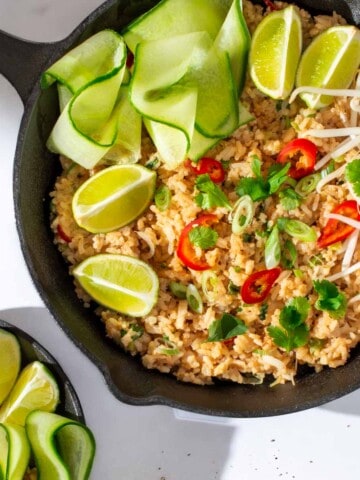
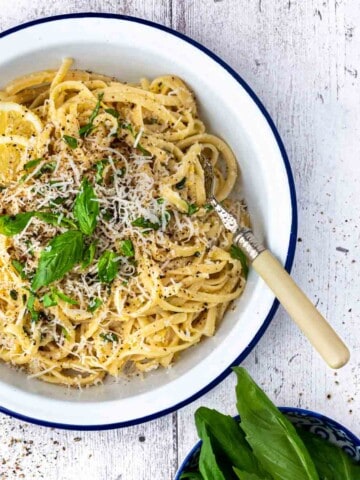
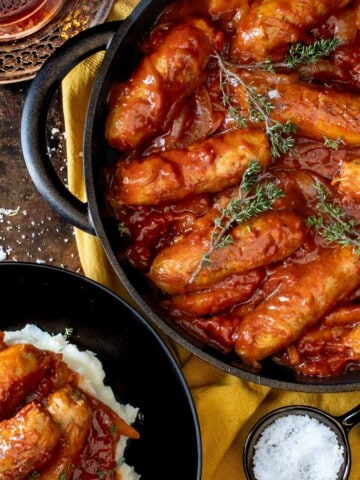

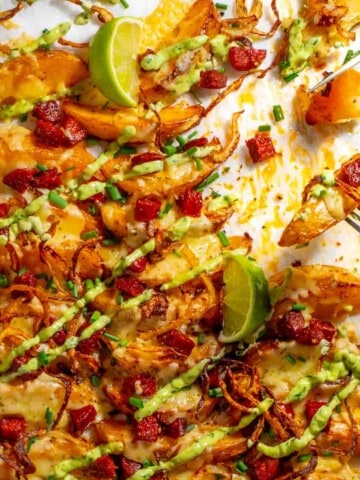
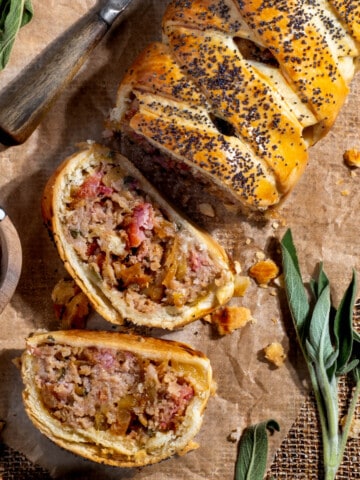
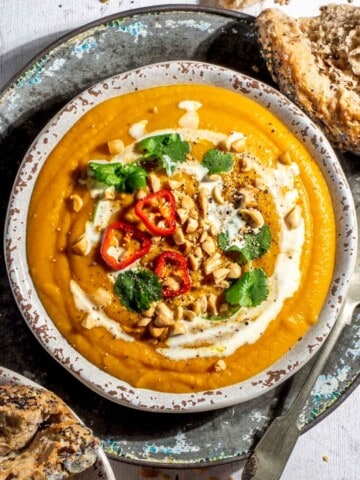
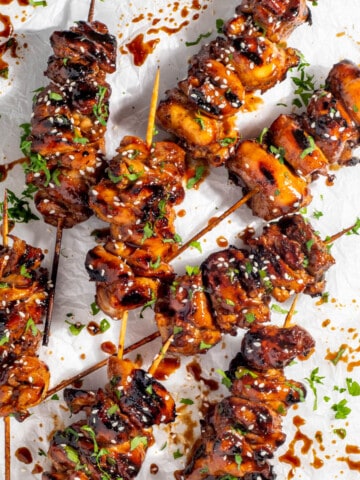
Leave a Reply